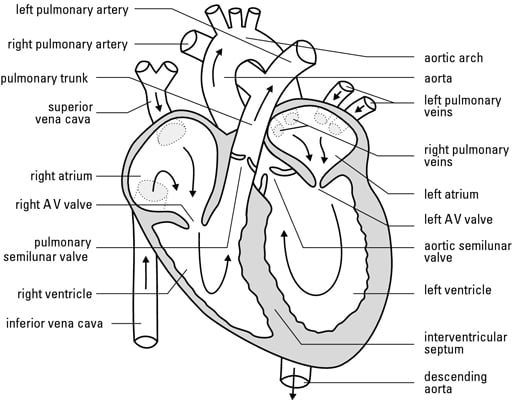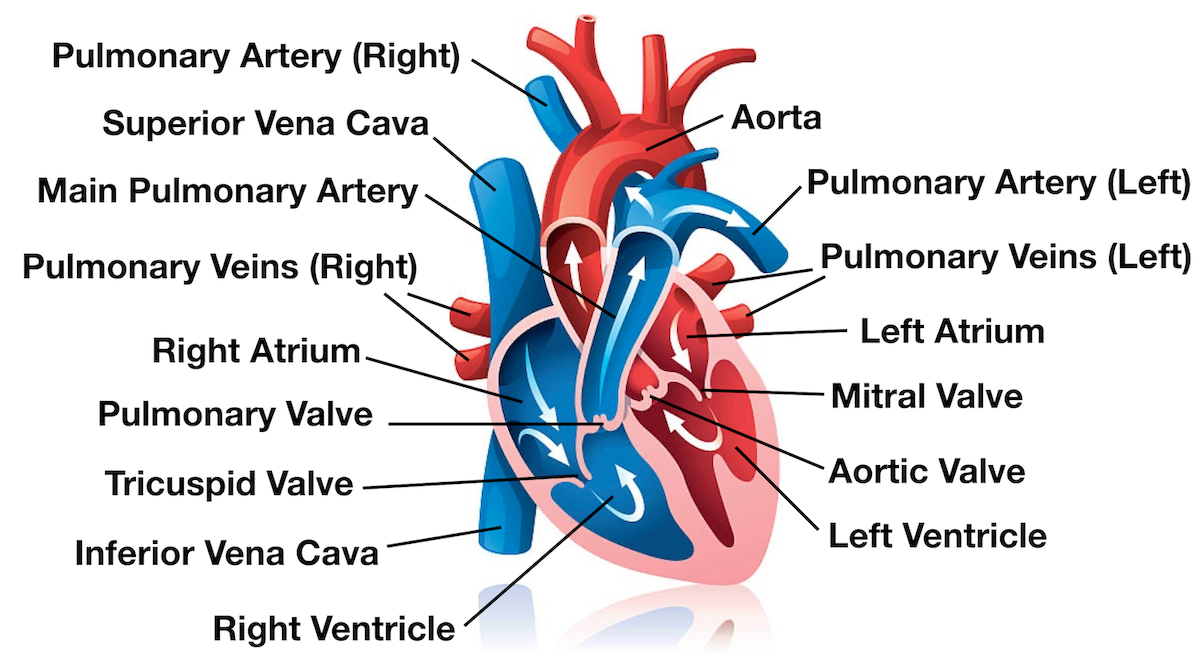Describe the Flow of Blood Through the Human Heart
Blood leaves the heart through the pulmonic. The trunk the main artery aorta branches into.

How Blood Flows Through The Human Heart Dummies
From the right atrium blood goes to the right ventricle.

. The path of blood through the heart also makes up a major part of the circulation because the heart also needs to be nourished and this is where both oxygenated and deoxygenated blood flow. The human heart is connected with blood vessels coming from around the body. The tricuspid valve between the right atrium and right ventricle prevents the backflow of blood.
The heart functions as a double ventricle. The heart is a large muscular organ which constantly pushes oxygen-rich blood to the brain and extremities and transports oxygen-poor blood from the brain and extremities to the lungs to gain oxygen. Before You Go Make Your Learning Experience Even Easier.
Deoxygenated blood from different organs comes to the right atrium through the vena cava. Describe the flow of blood through the heart of human beings. There are 6 main steps or structures in which blood flows through the right side of the heart.
From the right ventricle. The blood circulatory system cardiovascular system delivers nutrients and oxygen to all cells in the body. Blood moves from the body into the right atrium and then into the right ventricle where it is pumped into the lungs.
This enhanced blood courses through the umbilical vein toward the childs liver. Blood enters the right atrium from the superior and inferior venae cavae and the coronary sinus. Oxygen and supplements from the mothers blood are moved across the placenta to the embryo through the umbilical rope.
Superior and inferior vena cavae and the coronary sinus 2. After picking up oxygen the. Blood becomes oxygenated in the lungs moves into the left atrium and into the left ventricle where it is pumped into the body again.
Next we have the left side of the heart shown in red. Blood flows from the right atrium into the right ventricle through the tricuspid valve. From the right ventricle it goes through the pulmonary semilunar valves to the pulmonary trunk 4.
Describe in detail the flow of blood through the heart and body. This prevents blood from flowing backward into the atria while the ventricles contract squeeze. Blood leaves the SVC and the IVC and enters the right atrium RA 3.
We first have the right side of the heart shown in blue below. Blood flows from your left atrium into your left ventricle through the open mitral valve. The blood is pumped into the blood vessels through the heart.
It consists of the heart and the blood vessels running through the entire body. Blood Flow Through the Heart. Deoxygenated blood from different organs comes to the right atrium through the vena cava.
Beginning with the superior and inferior vena cavae and the coronary sinus the flowchart below summarizes the flow of blood through the heart including all arteries veins and valves that are passed along the way. The arteries carry blood away from the heart. Blood flow in the unborn child follows this pathway.
The system of blood vessels resembles a tree. From the right atrium blood goes to the right ventricle. Flow of blood through human heart Oxygen rich blood from the lungs comes to the thin-walled upper chamber of the heart on the left the left atrium.
The IVC collects blood from the lower half of the body. The SVC collects blood from the upper half of the body. Pathway of blood through the heart 1.
What are the 14 steps of blood flow through the heart. Discuss the systemic and pulmonary circulatory systems and how the coronary system fits in. The heart is made of four.
Blood goes to the lungs through pulmonary artery. The tricuspid valve between the right atrium and right ventricle prevents the backflow of blood. The easiest way to understand the blood flow through the heart is to divide the heart into 2 sides.
Blood flow through the heart is a result of differences in pressure created by blood flow as well as depolarizationcontraction and repolarizationrelaxation. There it travels through a shunt called the ductus venosus. Blood enters the heart through two large veins the inferior and superior vena cava emptying oxygen-poor blood from the body into the right atrium of the heart.
Blood flows through the heart in the following order. The veins carry it back to the heart. As the ventricle contracts blood leaves the heart through the pulmonic valve into the pulmonary artery and to the lungs where it is oxygenated.
Blood comes into the right atrium from the body moves into the right ventricle and is pushed into the pulmonary arteries in the lungs. From the right ventricle of the heart blood is pumped through the pulmonary semilunar valve into the left and right pulmonary arteries one for each lung and travels through the lungs. The left atrium relaxes when it is collecting this blood.
When the ventricles are full the tricuspid valve shuts. All blood enters the right side of the heart through two veins. Describe the flow of blood through the heart of human beings.
Blood flows from your right atrium into your right ventricle through the open tricuspid valve. When the ventricle is full the tricuspid valve shuts to prevent blood flowing backwards into the atrium. Chambers of the Heart.
As the heart contracts it pumps blood into your blood vessels which then circulate the blood to the body before it goes back again to the heart. This pumping of blood goes through a complex process where in the deoxygenated blood or impure blood is cleansed and oxygenated blood or pure blood is sent throughout the body. The pulmonary arteries carry deoxygenated blood to the lungs where they release carbon dioxide and pick up oxygen during respiration.
1 body 2 inferiorsuperior vena cava 3 right atrium 4 tricuspid valve 5 right ventricle 6 pulmonary arteries 7 lungs 8 pulmonary veins 9 left atrium 10 mitral or bicuspid valve 11 left ventricle 12. From the right ventricle blood goes to the lungs. The cardiovascular or circulatory system is an important organ system of your body as it makes the blood flow through the heart so it can transport oxygen hormones carbon dioxide blood cells and nutrients to and from your body cells for nourishing the body helping it fight diseases stabilizing pH and temperature and maintaining homeostasisFor all these.
The superior vena cava SVC and the inferior vena cava IVC see figure 3. From right atrium it goes through the tricuspid valve to the right ventricle.

Blood Flow Through The Heart Step By Step Diagram

The Direction Of Blood Flow Through The Heart Human Heart Transparent Png 663x600 Free Download On Nicepng

Comments
Post a Comment